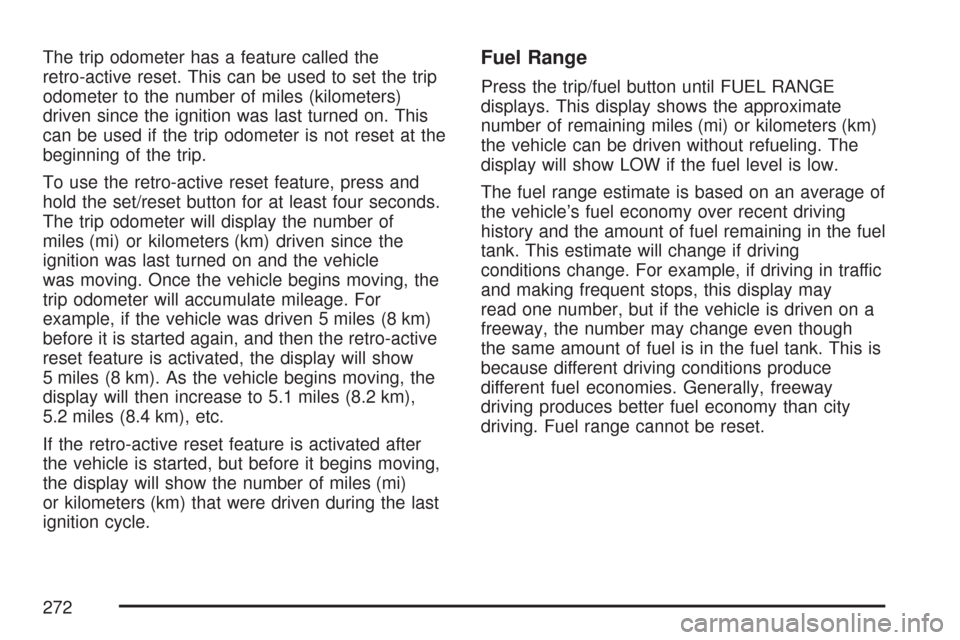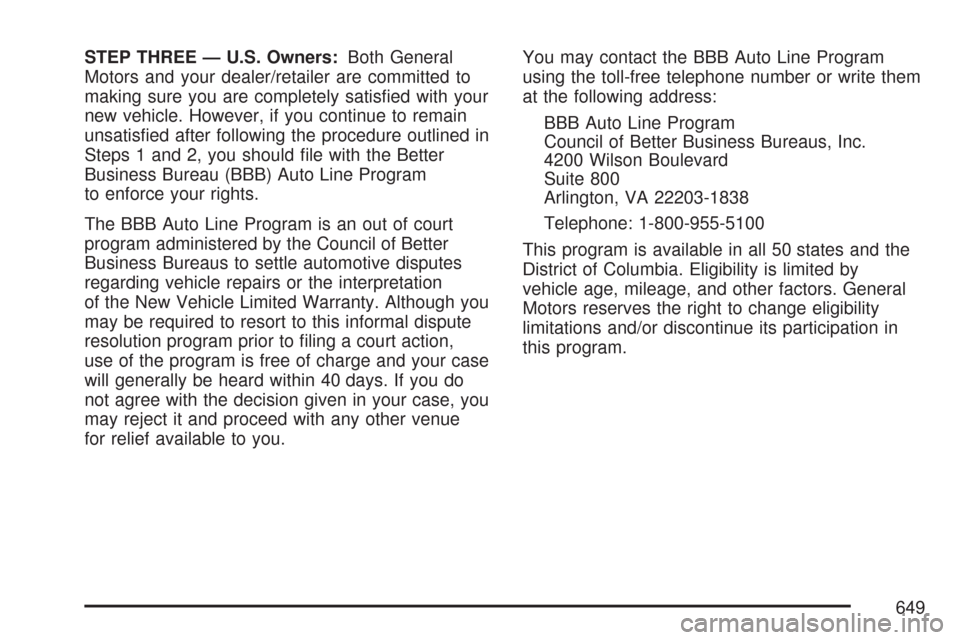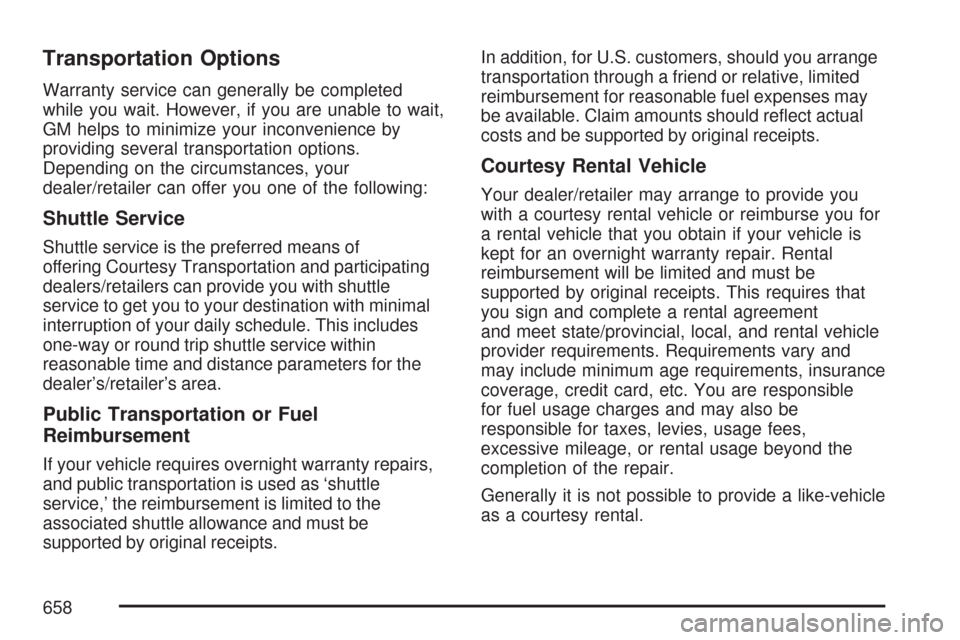2007 CHEVROLET SILVERADO mileage
[x] Cancel search: mileagePage 272 of 684

The trip odometer has a feature called the
retro-active reset. This can be used to set the trip
odometer to the number of miles (kilometers)
driven since the ignition was last turned on. This
can be used if the trip odometer is not reset at the
beginning of the trip.
To use the retro-active reset feature, press and
hold the set/reset button for at least four seconds.
The trip odometer will display the number of
miles (mi) or kilometers (km) driven since the
ignition was last turned on and the vehicle
was moving. Once the vehicle begins moving, the
trip odometer will accumulate mileage. For
example, if the vehicle was driven 5 miles (8 km)
before it is started again, and then the retro-active
reset feature is activated, the display will show
5 miles (8 km). As the vehicle begins moving, the
display will then increase to 5.1 miles (8.2 km),
5.2 miles (8.4 km), etc.
If the retro-active reset feature is activated after
the vehicle is started, but before it begins moving,
the display will show the number of miles (mi)
or kilometers (km) that were driven during the last
ignition cycle.Fuel Range
Press the trip/fuel button until FUEL RANGE
displays. This display shows the approximate
number of remaining miles (mi) or kilometers (km)
the vehicle can be driven without refueling. The
display will show LOW if the fuel level is low.
The fuel range estimate is based on an average of
the vehicle’s fuel economy over recent driving
history and the amount of fuel remaining in the fuel
tank. This estimate will change if driving
conditions change. For example, if driving in traffic
and making frequent stops, this display may
read one number, but if the vehicle is driven on a
freeway, the number may change even though
the same amount of fuel is in the fuel tank. This is
because different driving conditions produce
different fuel economies. Generally, freeway
driving produces better fuel economy than city
driving. Fuel range cannot be reset.
272
Page 278 of 684

Trip Odometer
Press the trip odometer reset stem until TRIP
displays. This display shows the current distance
traveled in either miles (mi) or kilometers (km)
since the last reset for the trip odometer.
The trip odometer can be reset to zero by pressing
and holding the trip odometer reset stem while
the trip odometer is displayed.
The trip odometer has a feature called the
retro-active reset. This can be used to set the trip
odometer to the number of miles (kilometers)
driven since the ignition was last turned on. This
can be used if the trip odometer is not reset at the
beginning of the trip.
To use the retro-active reset feature, press and
hold the trip odometer reset stem for at least four
seconds. The trip odometer will display the
number of miles (mi) or kilometers (km) driven
since the ignition was last turned on and the
vehicle was moving. Once the vehicle begins
moving, the trip odometer will accumulate mileage.
For example, if the vehicle was driven 5 miles
(8 km) before it is started again, and then
the retro-active reset feature is activated, thedisplay will show 5 miles (8 km). As the vehicle
begins moving, the display will then increase
to 5.1 miles (8.2 km), 5.2 miles (8.4 km), etc.
If the retro-active reset feature is activated after
the vehicle is started, but before it begins moving,
the display will show the number of miles (mi)
or kilometers (km) that were driven during the last
ignition cycle.
Transmission Temperature
Press the trip odometer reset stem until TRANS
TEMP displays. This display shows the
temperature of the automatic transmission �uid in
either degrees Fahrenheit (°F) or degrees
Celsius (°C).
Trailer Gain and Output
On vehicles with the Integrated Trailer Brake
Control (ITBC) system, the trailer brake display
appears in the DIC. Press the trip odometer reset
stem until TRAILER GAIN and OUTPUT display.
TRAILER GAIN shows the trailer gain setting. This
setting can be adjusted from 0.0 to 10.0 with
either a trailer connected or disconnected.
278
Page 489 of 684

California Proposition 65 Warning
Most motor vehicles, including this one, contain
and/or emit chemicals known to the State of
California to cause cancer and birth defects or other
reproductive harm. Engine exhaust, many parts and
systems (including some inside the vehicle), many
�uids, and some component wear by-products
contain and/or emit these chemicals.
Doing Your Own Service Work
{CAUTION:
You can be injured and your vehicle could
be damaged if you try to do service work
on a vehicle without knowing enough
about it.
Be sure you have sufficient knowledge,
experience, the proper replacement
parts, and tools before you attempt any
vehicle maintenance task.
CAUTION: (Continued)
CAUTION: (Continued)
Be sure to use the proper nuts, bolts,
and other fasteners. English and
metric fasteners can be easily
confused. If you use the wrong
fasteners, parts can later break or fall
off. You could be hurt.
If you want to do some of your own service work,
you should use the proper service manual. It
tells you much more about how to service your
vehicle than this manual can. To order the proper
service manual, seeService Publications
Ordering Information on page 666.
Your vehicle has an airbag system. Before
attempting to do your own service work, see
Servicing Your Airbag-Equipped Vehicle on
page 104.
You should keep a record with all parts receipts
and list the mileage and the date of any service
work you perform. SeeMaintenance Record
on page 644.
489
Page 505 of 684

GM Goodwrench®oil meets all the requirements
for your vehicle.
If you are in an area of extreme cold, where the
temperature falls below−20°F (−29°C), it is
recommended that you use either an SAE 5W-30
synthetic oil or an SAE 0W-30 oil. Both provide
easier cold starting and better protection for
the engine at extremely low temperatures.
Engine Oil Additives
Do not add anything to the oil. The recommended
oils with the starburst symbol that meet GM
Standard GM6094M are all you need for good
performance and engine protection.
Engine Oil Life System
When to Change Engine Oil
Your vehicle has a computer system that lets you
know when to change the engine oil and �lter. This
is based on engine revolutions and engine
temperature, and not on mileage. Based on driving
conditions, the mileage at which an oil change will
be indicated can vary considerably. For the oil life
system to work properly, you must reset the system
every time the oil is changed.When the system has calculated that oil life has
been diminished, it will indicate that an oil change is
necessary. A CHANGE ENGINE OIL SOON
message will come on. SeeDIC Warnings and
Messages on page 281. Change your oil as soon
as possible within the next 600 miles (1 000 km). It
is possible that, if you are driving under the best
conditions, the oil life system may not indicate that
an oil change is necessary for over a year.
However, your engine oil and �lter must be
changed at least once a year and at this time the
system must be reset. Your dealer has GM-trained
service people who will perform this work using
genuine GM parts and reset the system. It is also
important to check your oil regularly and keep it at
the proper level.
If the system is ever reset accidentally, you must
change your oil at 3,000 miles (5 000 km)
since your last oil change. Remember to reset the
oil life system whenever the oil is changed.
505
Page 636 of 684

At Each Fuel Fill
It is important to perform these underhood checks
at each fuel �ll.
Engine Oil Level Check
Check the engine oil level and add the proper oil if
necessary. SeeEngine Oil (Gasoline Engine)
on page 502for further details.
Notice:It is important to check the engine oil
regularly and keep it at the proper level.
Failure to keep the engine oil at the proper
level can cause damage to the engine not
covered by your warranty.
Engine Coolant Level Check
Check the engine coolant level and add
DEX-COOL®coolant mixture if necessary. See
Engine Coolant on page 514for further details.
Windshield Washer Fluid Level Check
Check the windshield washer �uid level in
the windshield washer �uid reservoir and add the
proper �uid if necessary.
At Least Once a Month
Tire In�ation Check
Visually inspect your vehicle’s tires and make sure
they are in�ated to the correct pressures. Do not
forget to check the spare tire. SeeIn�ation - Tire
Pressure on page 561. Check to make sure the
spare tire is stored securely. SeeChanging a Flat
Tire on page 580.
Tire Wear Inspection
Tire rotation may be required for high mileage
highway drivers prior to the Engine Oil Life System
service noti�cation. Check the tires for wear
and, if necessary, rotate the tires. SeeTire
Inspection and Rotation on page 568.
636
Page 648 of 684

Customer Assistance and
Information
Customer Satisfaction Procedure
Your satisfaction and goodwill are important
to your dealer/retailer and to Chevrolet. Normally,
any concerns with the sales transaction or the
operation of your vehicle will be resolved by your
dealer’s/retailer’s sales or service departments.
Sometimes, however, despite the best intentions of
all concerned, misunderstandings can occur. If
your concern has not been resolved to your
satisfaction, the following steps should be taken:
STEP ONE:Discuss your concern with a member
of dealership/retailer management. Normally,
concerns can be quickly resolved at that level. If
the matter has already been reviewed with
the sales, service, or parts manager, contact the
owner of the dealership/retailer or the general
manager.STEP TWO:If after contacting a member of
dealership/retailer management, it appears your
concern cannot be resolved by the dealership/
retailer without further help, in the U.S., contact the
Chevrolet Customer Assistance Center by
calling 1-800-222-1020. In Canada, contact
General Motors of Canada Customer
Communication Centre by calling 1-800-263-3777
(English) or 1-800-263-7854 (French).
We encourage you to call the toll-free number in
order to give your inquiry prompt attention. Please
have the following information available to give
the Customer Assistance Representative:
Vehicle Identi�cation Number (VIN). This is
available from the vehicle registration or
title, or the plate at the top left of the
instrument panel and visible through the
windshield.
Dealership/retailer name and location.
Vehicle delivery date and present mileage
(kilometers).
When contacting Chevrolet, please remember that
your concern will likely be resolved at a
dealer’s/retailer’s facility. That is why we suggest
you follow Step One �rst if you have a concern.
648
Page 649 of 684

STEP THREE — U.S. Owners:Both General
Motors and your dealer/retailer are committed to
making sure you are completely satis�ed with your
new vehicle. However, if you continue to remain
unsatis�ed after following the procedure outlined in
Steps 1 and 2, you should �le with the Better
Business Bureau (BBB) Auto Line Program
to enforce your rights.
The BBB Auto Line Program is an out of court
program administered by the Council of Better
Business Bureaus to settle automotive disputes
regarding vehicle repairs or the interpretation
of the New Vehicle Limited Warranty. Although you
may be required to resort to this informal dispute
resolution program prior to �ling a court action,
use of the program is free of charge and your case
will generally be heard within 40 days. If you do
not agree with the decision given in your case, you
may reject it and proceed with any other venue
for relief available to you.You may contact the BBB Auto Line Program
using the toll-free telephone number or write them
at the following address:
BBB Auto Line Program
Council of Better Business Bureaus, Inc.
4200 Wilson Boulevard
Suite 800
Arlington, VA 22203-1838
Telephone: 1-800-955-5100
This program is available in all 50 states and the
District of Columbia. Eligibility is limited by
vehicle age, mileage, and other factors. General
Motors reserves the right to change eligibility
limitations and/or discontinue its participation in
this program.
649
Page 658 of 684

Transportation Options
Warranty service can generally be completed
while you wait. However, if you are unable to wait,
GM helps to minimize your inconvenience by
providing several transportation options.
Depending on the circumstances, your
dealer/retailer can offer you one of the following:
Shuttle Service
Shuttle service is the preferred means of
offering Courtesy Transportation and participating
dealers/retailers can provide you with shuttle
service to get you to your destination with minimal
interruption of your daily schedule. This includes
one-way or round trip shuttle service within
reasonable time and distance parameters for the
dealer’s/retailer’s area.
Public Transportation or Fuel
Reimbursement
If your vehicle requires overnight warranty repairs,
and public transportation is used as ‘shuttle
service,’ the reimbursement is limited to the
associated shuttle allowance and must be
supported by original receipts.In addition, for U.S. customers, should you arrange
transportation through a friend or relative, limited
reimbursement for reasonable fuel expenses may
be available. Claim amounts should re�ect actual
costs and be supported by original receipts.
Courtesy Rental Vehicle
Your dealer/retailer may arrange to provide you
with a courtesy rental vehicle or reimburse you for
a rental vehicle that you obtain if your vehicle is
kept for an overnight warranty repair. Rental
reimbursement will be limited and must be
supported by original receipts. This requires that
you sign and complete a rental agreement
and meet state/provincial, local, and rental vehicle
provider requirements. Requirements vary and
may include minimum age requirements, insurance
coverage, credit card, etc. You are responsible
for fuel usage charges and may also be
responsible for taxes, levies, usage fees,
excessive mileage, or rental usage beyond the
completion of the repair.
Generally it is not possible to provide a like-vehicle
as a courtesy rental.
658